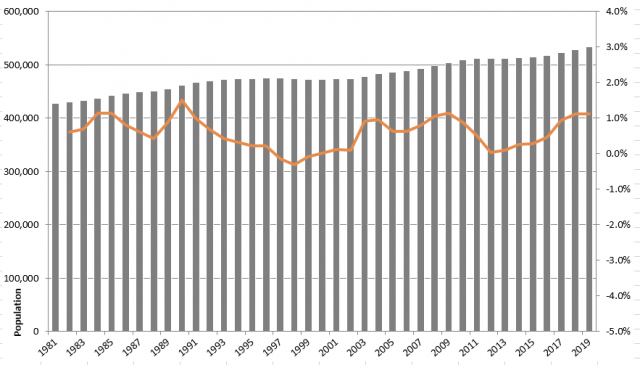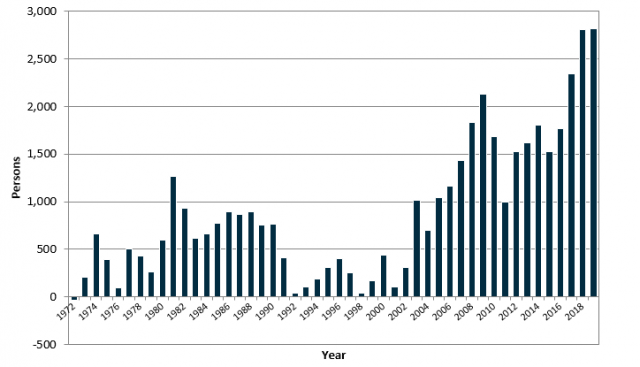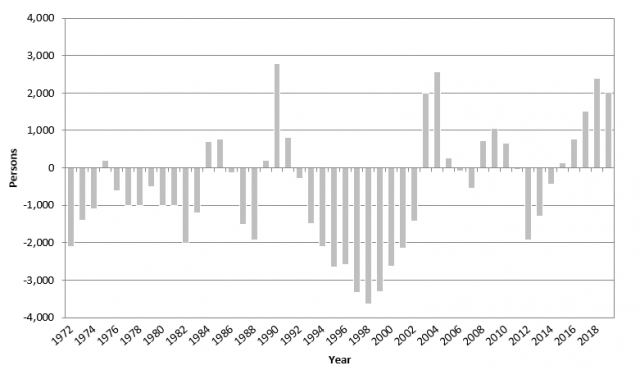Something remarkable has happened in the last few years, for keen observers of population growth in Australia. Our smallest state, Tasmania, is growing again! In fact, in the last 2 years, the Apple Isle has grown faster than SA and WA, at around 1.1%, which, while still below the national growth rate in 2019 of 1.5%, is substantial for Tasmania. In this post, Glenn shares some insights from the new community and economic profiles made publicly available by .id and the Tasmanian Department of State Growth.
If you work at a Tasmanian Local Council and would like to delve further into the characteristics of the individual places in your communities, see migration trends at the local level and look at educational and income characteristics, please contact us here to discuss the option of making these resources available for your local government area.
Typically over the last century, Tasmania’s population has not grown rapidly. While it was the second state to be settled by Europeans, with population statistics back to 1803, it has fallen behind the other states. Isolated by Bass Strait, it has our oldest median age of 42, among the lowest average incomes in the country, and has been able to attract relatively few people to live there. But that is changing, and quite rapidly.
These charts show Tasmania’s population and growth rate over the past 40 years. The last 3 years, in particular, have shown strong growth. Tasmania’s population in June 2019 was 534,281, an increase of almost 20,000 since 2015. This is not huge in numerical terms compared to other states, but remember that Tasmania overall only contains about 2% of Australia’s population. Tasmania is adding about 6,000 people every year at the moment.
Tasmania – population and % population growth, past 40 years

Tasmania – absolute population growth by year, 1982-2019

Source: ABS 3101.0 Australian Demographic Statistics, June 2019
This growth rate is not due to natural increase (births-deaths) which tends to add around 1,000 people to Tasmania’s population every year. Most of it is due to a combination of overseas and interstate migration.
Tasmania has been successful in setting a number of refugee communities in recent years, particularly in Launceston, and the northern suburbs of Hobart (Glenorchy). These include groups from places like Nepal and Bhutan, as well as Iran and Afghanistan. Overseas migration is the highest it’s been in a century, and this makes up around 50% of population growth.
Overseas migration to Tasmania, 1972-2019

Interstate migration to Tasmania, 1972-2019
Another big trend is interstate migration. People are consistently coming to Tasmania from the mainland. The 2018 and 2019 financial years each saw net interstate migration of over 2,000 people, and it’s been positive the last 5 years straight, though down in the last year just a little from the peak. Typically Tasmania’s interstate migration is negative, so this is quite unusual, and shows no signs of abating.

Source: ABS 3101.0 Australian Demographic Statistics, June 2019
So where are they coming from? This table shows that Tasmania’s biggest population inflow is from Victoria, but it’s a bigger outflow. Victoria is actually the only state Tasmania is still losing population to. All other states and territories are net gains to Tassie, but by far the largest share is from New South Wales.
| Tasmania interstate migration, 2018-19 |
|
Arrivals |
Departures |
Net |
| New South Wales |
|
3,547 |
2,116 |
1,431 |
| Victoria |
|
4,119 |
4,281 |
-162 |
| Queensland |
|
3,815 |
3,600 |
215 |
| South Australia |
|
817 |
716 |
101 |
| Western Australia |
|
1,444 |
1,201 |
243 |
| Northern Territory |
|
436 |
281 |
155 |
| Australian Capital Territory |
|
355 |
330 |
25 |
Source: ABS.stat data based on 3101.0 Australian Demographic Statistics, June 2019
Where are migrants settling in Tasmania?
We don’t yet have the 2019 data yet for this, it’s released in March. But using the 2018 dataset, shows that the 1-year population growth is spread across Tasmania, with only 2 LGAs recording population decline in that time. Flinders Island recorded the fastest growth, of 3.1%, but this is from a very small population base of less than 1,000 people. Sorell and Huon Valley are also growing strongly. Approximately 60% of the annual growth is in the Greater Hobart area.

What does all this mean?
Well, Tasmania is the only state with a Department of State Growth – and they recently commissioned .id to produce a community and economic profile for the entire state of Tasmania. Using these sites you can look at the Census characteristics of any Local Government Area (or the whole state) for Tasmania, and see how it has changed over the past 4 Census periods. You can see the community profile here and the economic profile here.
This is public access, a resource for all Tasmanians and those interested in the state, and will be updated when the 2021 Census data comes around – don’t forget that quite a bit of the growth we’re now seeing is of course after the 2016 Census.
How is the Tasmanian economy responding?
Tasmania’s economy is also growing strongly, around 3% p.a. at the moment.

The largest single sector in the economy is Health Care and Social Assistance, but Agriculture, Forestry and Fishing actually grew by the most in the last year.

Feel free to check out these free resources provided by .id and the Department of State Growth!
















